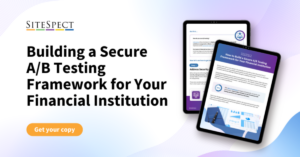A/B Testing for Mobile Apps: How to Build Effective Experiments
By Mike Fradkin
September 21, 2023
Share
It was reported that Amazon increased its revenue by a massive 35% in one year, all thanks to effective A/B testing. Running these experiments can deliver huge results on websites (like Amazon’s), but what about A/B testing for mobile apps?
Of course, it can boost your conversion rates and help optimize your user experience as you would with a website, but A/B testing can also improve your mobile app engagement by 72%, as stated in a recent survey.
And with only 7% of companies believing it’s difficult to perform A/B tests, there’s no reason why you shouldn’t make it a priority with your mobile apps, too. But the question is, how do you actually establish effective A/B testing for mobile apps? Especially when A/B testing mobile apps is often hindered by:
- Writing and maintaining numerous SDKs
- Managing mobile app store resubmissions
- Maintaining a consistent experience across devices
- The need for users to refresh apps to see the implemented changes
In this blog, we’re sharing the 6 essential steps to building these highly beneficial experiments. Plus, we’re offering key insights we’ve gained over our years of experience, along with actionable tips to get your mobile app A/B tests off and running. Let’s begin!
Step 1 – Determine What You Want to A/B Test
The main question we hear time and time again when it comes to A/B testing for mobile apps is: What should I test? It’s a great question, but it doesn’t garner a clear-cut response. You should start by asking yourself what your primary goals are.
Are you a developer looking to improve the mobile app user experience or boost engagement? What about a marketer trying to optimize conversion rates or maximize the effectiveness of your mobile app marketing campaign?
Determining what your objectives are upfront will give you the best starting point. So what changes to your app will help you reach these goals? Here are a few areas to consider in A/B testing for mobile apps:
- Copy: Experiment with different copy elements, such as headlines, product descriptions, and call-to-action buttons to find the language that resonates best with your audience and drives action.
- App layout: Optimize user navigation and experience by testing layout variations, rearranging elements, and adjusting menu structures to maximize interaction and engagement.
- Push notifications: Refine your push notification strategy through A/B testing by assessing timing, content, and frequency to maintain user engagement without overwhelming them.
- User checkout journey: Streamline the checkout process by experimenting with the number of steps, clarity of instructions, and placement of trust signals to reduce cart abandonment and boost conversions.
- Personalized product/video recs: Enhance user engagement by testing different recommendation algorithms and widget placements to deliver tailored content, increasing user satisfaction and conversion rates.
No matter what you decide to test, focus on setting clear and attainable objectives. A well-defined goal and a structured approach will help you in the next step—developing your hypotheses.
Step 2 – Develop Your Hypothesis
With your objectives clearly defined in Step 1, it’s time to move on to developing your hypothesis. This step bridges the gap between your goals and the actionable changes you’ll soon make within your app.
To clearly define your hypothesis, follow this simple (but effective) structure:
- If (change): This could be altering the design, modifying a feature, or adjusting the placement of a call-to-action button.
- Then (expected outcome): Clearly state what you expect to happen as a result of this change. Use data and research to back up your expectations.
- Because (reasoning): Provide a reason why you believe this change will lead to the expected outcome.
Here’s an example hypothesis when you put it all together:
“If we move the ‘Sign Up’ button to the home screen, then we expect to see a 30% increase in sign-up conversions because we made the button more accessible.”
A well-structured hypothesis based on data and insights should guide your experimentation process. This will keep you from blindly A/B testing at random so you’re not spinning your wheels out of the gate.
Step 3 – Segment Your Audience Based on Variables
Why segment your audience? The answer is actually quite simple: Your app users have widely varying preferences and behaviors. Segmenting your audience allows you to personalize the app experience, tailoring it to specific groups for the best results.
Before you can effectively segment your audience, you need to identify the variables that matter most for your app and goals. These variables could include (but are not limited to):
- Demographics
- Behavioral data
- Device and operating systems
- Source of traffic
- User preferences
With SiteSpect, you could even segment based on the device used since you can remotely configure apps on any internet-connected device (IoT, OTT, kiosk, mobile, tablet, SPA app frameworks, etc). Once you’ve identified your variables, it’s time to group relevant users together within an audience segment. For example, you could have a segment consisting of male iPhone users, aged 20-35, located in the U.S., who have made a purchase in the last 30 days.
Now that you’ve defined your audiences, you’ll be ready for the next step of building out your A/B tests for multiple user groups.
Step 4 – Build Your A/B Tests with SiteSpect
In this step, you’ll input the data you’ve collected in the previous step into your A/B testing platform. Also, you’ll want to spend some time deciding on your testing duration and traffic allocation for best results.
SiteSpect simplifies the building process with versatility and powerful features. Why would you want to use our A/B testing solution for your mobile apps? Here are a few reasons:
- SiteSpect’s transformation engine enables mobile app testing without the traditional friction of SDKs and app store resubmissions.
- You can make changes to your app in real time, without requiring app store updates. This agility is crucial for swift testing iterations.
- SiteSpect enables precise audience segmentation and personalization, helping you target the right users on any internet-connected device.
- It seamlessly integrates with various data sources, allowing you to combine A/B testing data with other insights for a holistic view.
- SiteSpect prioritizes data security and compliance, ensuring your tests meet industry standards and regulations.
Before you begin building out your experiments, take a moment to consider if your current solution (specifically A/B testing for mobile apps) is up to par. Once you’re happy with your solution, it’s time to plug in your criteria and launch your tests.
➡️ See how SiteSpect stacks up against the competition.
Step 5 – Perform a Deep Analysis of the Results
You’ve done your research, built your mobile app A/B tests, and run your experiments. Great! Now it’s time to analyze the results of your work.
The true power of A/B testing for mobile apps lies in data-driven decision-making. A deep analysis helps you interpret the data accurately, leading to informed choices for your app’s improvement. You’ll want to look for patterns and trends to help you understand why certain changes had (or didn’t have) specific effects.
During your analysis, you’ll come to various conclusions. Some will be positive, some negative, and others may be inconclusive. Regardless of the outcome you find, you’ll have the chance to learn key takeaways from each of your findings. Document the results with your teams—whether positive, negative, or inconclusive—and lead an open discussion for collaborative decision-making and next steps.
Performing this deep analysis of your A/B testing results is the culmination of your efforts to optimize and improve your mobile app. This is where data meets insight, and informed decisions are made to meet or exceed your goals.
Step 6 – Implement Changes Based on Results
After a thorough analysis of your A/B testing results, it’s time to take action.
Here’s the deal; A/B testing your mobile app is only as valuable as the insights you gain and how you apply them. Implementation is where you convert your insights into actual enhancements that directly benefit your company and your app users.
The mobile app landscape is quite dynamic. As such, regularly making updates and improvements ensures your app remains competitive, user-friendly, and aligned with the ever-changing user expectations. Plus, your changes will directly impact the goals you laid out in the first step.
Be it increased user engagement, higher conversions, or improved app performance, it all comes from testing, analyzing the data, and taking action. Here are a few common scenarios you might encounter:
- Immediate Success: If an A/B test variation shows significant improvement, serve the winning variation to all traffic to reap immediate benefit. This can happen automatically with SiteSpect’s auto optimization feature. Also, make sure to add it to your development pipeline to get it folded into the codebase.
- Partial Success: If a variation has some positive impact but not across all metrics, consider refining and testing it further before full implementation.
- Negative Impact: If a variation had an unfavorable effect, revert to the original design and analyze what went wrong. Learn from the experience and adjust your strategy accordingly.
- Segment-Specific Changes: For experiments that yielded segment-specific insights, apply changes selectively to the relevant user groups.
Regardless of your findings, you are ready to take action, except for one problem—you’ll need to submit your new app update to the respective app stores and begin the waiting game. Days turn into weeks and suddenly, you’ve lost your momentum.
Not with SiteSpect. Since our solution sits in the flow of traffic between the servers and devices, you can conduct A/B tests at the server level so the changes happen in real time. This means your users will experience the winning changes without needing to update their apps!
You’ll want to keep in mind that A/B testing is an iterative process. Even after implementing changes and experiencing success, continue to monitor user behavior and gather feedback as this is an evolving process.
Final Thoughts
A/B testing isn’t a one-time affair; it’s a continuous journey of refinement and growth. Your app’s success depends on your ability to adapt, iterate, and stay attuned to your user’s changing needs.
At SiteSpect, we aim to be more than just a tool that helps you get the job done. We are your strategic partner in the journey of continuous refinement and growth. You’ll be able to kick off each new campaign with the confidence you need with our advanced A/B testing platform.
Ready to gain your competitive edge? Schedule your free SiteSpect demo and start A/B testing your mobile app today.
Share
Suggested Posts
Subscribe to our blog:





